XR1-IPEX Module Datasheet
Last Updated on : 2025-07-10 02:15:00download
XR1-IPEX is a low-power embedded Wi-Fi module that Tuya has developed. It consists of a highly integrated RF chip (XR809) and several peripheral components, with an embedded Wi-Fi network protocol stack and robust library functions.
Overview
XR1-IPEX is embedded with an Arm Cortex-M4F CPU, 2 MB flash read-only memory (ROM), and 384 KB static random-access memory (SRAM), and has extensive peripherals.
Features
- Working voltage: 2.7 V to 5.5 V
- Clock rate: 160 MHz
- Peripherals: 6×GPIOs, 2×UART, 1×ADC
- Wi-Fi connectivity
- 802.11b/g/n
- Channels 1 to 14 at 2.4 GHz (CH1-11 for US/CA, CH1-13 for EU/CN)
- WPA and WPA2 security modes
- STA, AP, and STA+AP working modes
- Smart and AP network configuration modes for Android and iOS devices
- External antenna IPEX connector
- Working temperature: –20°C to +85°C
Applications
- Intelligent building
- Smart household and home appliances
- Smart socket and light
- Industrial wireless control
- Network camera
- Intelligent bus
Module interfaces
XR1-IPEX has two rows of 18 pins with a 1.5 mm pin spacing.
The XR1-IPEX dimensions (H x W x D) are 3.5±0.15 mm x 18±0.35 mm x 23.5±0.35 mm. The PCB thickness is 1.0±0.1 mm. The Shielding case thickness is 2.5±0.05 mm.
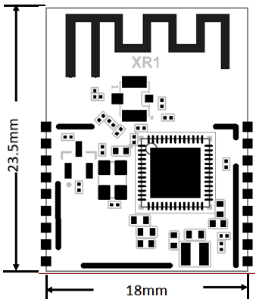

Interface pin definition
| Pin No. | Symbol | I/O type | Function |
|---|---|---|---|
| 1 | VIN | P | TXD1 level convertor, 5V or 3.3V |
| 2 | TXD1 | I/O | Serial interface transmission pin (UART_TX), which is connected to PA17 (pin 39) on the internal IC |
| 3 | RXD1 | I/O | Serial interface receiving pin (UART_RX), which is connected to PA18 (pin 40) on the internal IC |
| 4 | VCC | P | Power input pin (3.3 V) |
| 5 | GND | P | Power supply reference ground pin |
| 6 | PA22 | I/O | PA22, which is connected to PA22 (pin 44) on the internal IC |
| 7 | PA21 | I/O | PA21, which is connected to PA21 (pin 43) on the internal IC |
| 8 | TXD0 | I/O | Can be used as a debugging serial interface pin and is connected to PB00 (pin 49) on the internal IC |
| 9 | PA12 | I/O | PA12, which is connected to PA12 (pin 30) on the internal IC |
| 10 | PA20 | I/O | PA20, which is connected to PA20 (pin 42) on the internal IC |
| 11 | RXD0 | I/O | Can be used as a debugging serial interface pin and is connected to PB01 (pin 48) on the internal IC |
| 12 | PA14 | I/O | PA14, which is connected to PA14 (pin 32) on the internal IC |
| 13 | PA19 | I/O | PA19, which is connected to PA19 (pin 41) on the internal IC |
| 14 | GND | P | Power supply reference ground pin |
| 15 | GND | P | Power supply reference ground pin |
| 16 | EN | I/O | Enable/Reset pin (This pin is active at a high level, and is at a high level by default.) |
| 17 | ADC | AI | ADC pin (See the following Note) |
| 18 | GND | P | Power supply reference ground pin |
| TP | PB02 | I/O | Connected to PB02 (pin 10) on the internal IC |
| TP | PB03 | I/O | Connected to PB03 (pin 11) on the internal IC |
Note:
- P indicates power supply pins, I/O indicates input/output pins, AI indicates analog input pins and TP indicates test pins.
- This pin can only function as an ADC input and not a common I/O. If this pin is not used, it must be disconnected. When this pin is used as an ADC input, the input voltage range is 0 V to 2.5 V.
- During firmware burning, both PB02 and PB03 need to be connected to a low level. When the module works properly, PB02 and PB03 cannot be connected to a low level simultaneously.
Electrical parameters
Absolute electrical parameters
| Parameter | Description | Minimum value | Maximum value | Unit |
|---|---|---|---|---|
| Ts | Storage temperature | –40 | 125 | °C |
| VDD | Power supply voltage | –0.3 | 5.8 | V |
| Static electricity voltage (human body model) | Tamb = 25°C | N/A | 4 | kV |
| Static electricity voltage (machine model) | Tamb = 25°C | N/A | 0.8 | kV |
Electrical conditions
| Parameter | Description | Minimum value | Typical value | Maximum value | Unit |
|---|---|---|---|---|---|
| Ta | Working temperature | –20 | N/A | 85 | °C |
| VDD | Working voltage | 2.7 | 3.3 | 5.5 | V |
| VIL | I/O low-level input | –0.3 | N/A | 1.32 | V |
| VIH | I/O high-level input | 2.06 | N/A | 3.6 | V |
| VOL | I/O low-level output | -0.3 | N/A | 0.4 | V |
| VOH | I/O high-level output | 2.9 | N/A | 3.3 | V |
| Imax | I/O drive current | -40 | N/A | 40 | mA |
| RPU | IO input pull-up resistance | 40 | - | 110 | KΩ |
| RPD | IO input pull-down resistance | 40 | - | 110 | KΩ |
RF current consumption
| Working status | Mode | Rate | TX power/receiving | Typical value | Unit |
|---|---|---|---|---|---|
| TX | 802.11b | 11 Mbit/s | +14 dBm | 145 | mA |
| TX | 802.11g | 54 Mbit/s | +13.5 dBm | 138 | mA |
| TX | 802.11n | MCS7 | +13 dBm | 140 | mA |
| RX | 802.11b | 11 Mbit/s | Constant receiving | 41 | mA |
| RX | 802.11g | 54 Mbit/s | Constant receiving | 41 | mA |
| RX | 802.11n | MCS7 | Constant receiving | 41 | mA |
Working current
| Working Mode | Working status (Ta = 25°C) | Typical value | Peak value* | Unit |
|---|---|---|---|---|
| EZ | The module is in EZ mode, and the Wi-Fi indicator blinks quickly. | 32 | 138 | mA |
| AP | The module is in AP mode, and the Wi-Fi indicator blinks slowly. | 43 | 144 | mA |
| Network connect | The internet is connected, and the Wi-Fi indicator always blinks. | 38 | 131 | mA |
| Network disconnect | The internet is disconnected, and the Wi-Fi indicator does not blink. | 37 | 148 | mA |
RF features
Basic RF features
| Parameter | Description |
|---|---|
| Frequency band | 2.412 GHz to 2.4835 GHz |
| Wi-Fi standard | IEEE 802.11b/g/n (channels 1 to 14) |
| Data transmission rate | 802.11b: 1, 2, 5.5, or 11 (Mbit/s) 802.11g: 6, 9, 12, 18, 24, 36, 48, or 54 (Mbit/s) 802.11n: HT20 MCS0 to MCS7 |
| Antenna type | U.FL RF connector to connect external ANT |
TX Performance
| Parameter | Minimum value | Typical value | Maximum value | Unit |
|---|---|---|---|---|
| Average RF output power, 802.11b CCK mode 11 Mbit/s | - | 14 | - | dBm |
| Average RF output power, 802.11g OFDM mode54 Mbit/s | - | 13.5 | dBm | |
| Average RF output power, 802.11n OFDM modeMCS7 | - | 13 | - | dBm |
| Frequency error | –20 | - | +20 | ppm |
| EVM under 802.11b CCK, 11 Mbit/s, 17.5 dBm | –15 | dB | ||
| EVM under 802.11g OFDM, 54 Mbit/s, 15.0 dBm | –29 | dB | ||
| EVM under 802.11n OFDM, MCS7, 14.0 dBm | –30 | dB |
RX Performance
| Parameter | Minimum value | Typical value | Maximum value | Unit |
|---|---|---|---|---|
| PER < 8%, 802.11b CCK mode1 Mbit/s | - | –89 | - | dBm |
| PER < 10%, 802.11g OFDM mode54 Mbit/s | - | –75 | - | dBm |
| PER < 10%, 802.11n OFDM modeMCS7 | - | –72 | - | dBm |
Antenna
Antenna type
Reserve IPEX interface for external antenna connected.
U.FL RF connector
U.FL RF connector parameters are shown in the figure below:
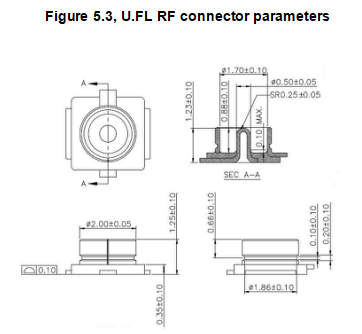
Packaging and production instructions
Mechanical dimensions


Recommended PCB layout
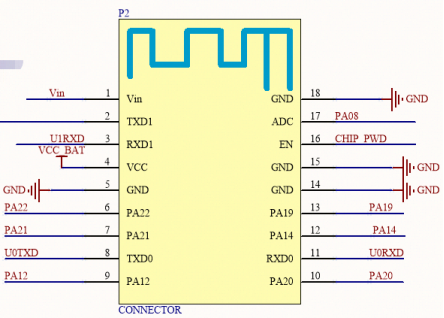
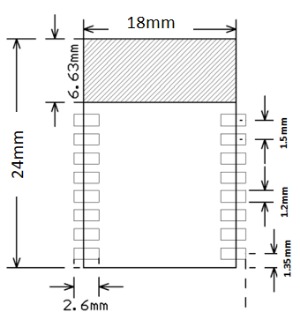
Production instructions
-
The stamp-hole module must be mounted by the SMT machine. After being unpacked, it must be soldered within 24 hours. Otherwise, it must be put into the drying cupboard where the RH is not greater than 10%, or it needs to be packaged under vacuum again and the exposure time needs to be recorded (the total exposure time cannot exceed 168 hours).
- SMT equipment:
- Mounter
- SPI
- Reflow soldering machine
- Oven temperature tester
- Automated optical inspection (AOI) equipment
- Baking equipment:
- Cabinet oven
- Anti-static heat-resistant pallets
- Anti-static heat-resistant gloves
- SMT equipment:
-
Storage conditions for a delivered module are as follows:
- The moisture-proof bag must be placed in an environment where the temperature is below 40°C and the relative humidity is lower than 90%.
- The shelf life of a dry-packaged product is 12 months from the date when the product is packaged and sealed.
- The package contains a humidity indicator card (HIC).
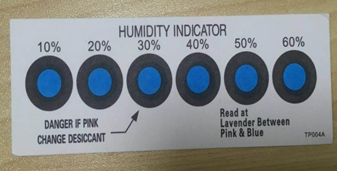
-
The module needs to be baked in the following cases:
- Vacuum packing bag was found to be damaged before being unpacked.
- There is no humidity indicator card (HIC) in the vacuum packing bag.
- After being unpacked, 10% and above circles on the HIC become pink.
- The total exposure time has been more than 168 hours since unpacking.
- More than 12 months have passed since the sealing date of the bag.
-
Baking settings:
- Temperature: 40°C and ≤ 5% RH for reel package and 125°C and ≤5% RH for tray package (please use the heat-resistant tray rather than a plastic container)
- Time: 168 hours for reel package and 12 hours for tray package
- Alarm temperature: 50°C for reel package and 135°C for tray package
- Production-ready temperature after natural cooling: < 36°C
- Re-baking situation: If a module remains unused for over 168 hours after being baked, it needs to be baked again.
- If a batch of modules is not baked within 168 hours, do not use the wave soldering to solder them. Because these modules are Level-3 moisture-sensitive devices, they are very likely to get damp when exposed beyond the allowable time. In this case, if they are soldered at high temperatures, it may result in device failure or poor soldering.
-
In the whole production process, take electrostatic discharge (ESD) protective measures.
-
To guarantee the passing rate, it is recommended that you use the SPI and AOI to monitor the quality of solder paste printing and mounting.
Recommended oven temperature curve
Perform mounting with the SMT based on the following reflow oven temperature curve. The highest temperature is 245°C. The reflow temperature curve is as below:
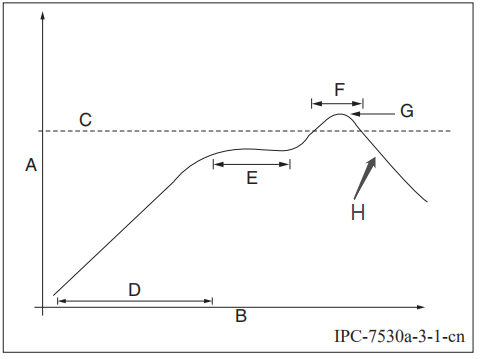
-
A: Temperature axis
-
B: Time axis
-
C: Liquidus temperature: 217 to 220°C
-
D: Ramp-up slope: 1 to 3°C/s
-
E: Duration of constant temperature: 60 to 120s; the range of constant temperature: 150 to 200°C
-
F: Duration above the liquidus: 50 to 70s
-
G: Peak temperature: 235 to 245°C
-
H: Ramp-down slope: 1 to 4°C/s
Note: The above curve is just an example of the solder paste SAC305. For more details about other solder pastes, please refer to Recommended oven temperature curve in the solder paste specifications.
Storage conditions
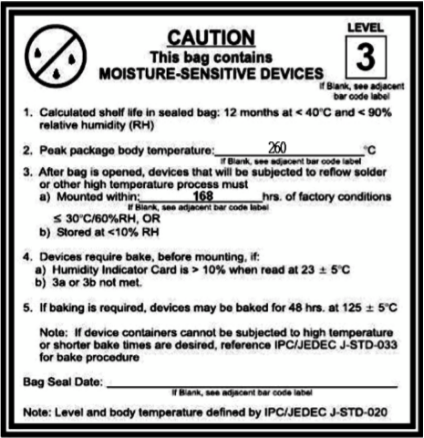
MOQ and packaging information
| Product number | MOQ (pcs) | Shipping packaging method | The number of modules per reel | The number of reels per carton |
|---|---|---|---|---|
| XR1-IPEX | 3600 | Tape reel | 900 | 4 |
Appendix: Statement
FCC Caution: Any changes or modifications not expressly approved by the party responsible for compliance could void the user’s authority to operate this device.
This device complies with Part 15 of the FCC Rules. Operation is subject to the following two conditions: (1) This device may not cause harmful interference, and (2) this device must accept any interference received, including interference that may cause undesired operation.
Note: This device has been tested and found to comply with the limits for a Class B digital device, according to part 15 of the FCC Rules. These limits are designed to provide reasonable protection against harmful interference in a residential installation. This device generates, uses, and can radiate radio frequency energy and, if not installed and used following the instructions, may cause harmful interference to radio communications. However, there is no guarantee that interference will not occur in a particular installation.
If this device does cause harmful interference to radio or television reception, which can be determined by turning the device off and on, the user is encouraged to try to correct the interference by one or more of the following measures:
- Reorient or relocate the receiving antenna.
- Increase the separation between the device and receiver.
- Connect the device into an outlet on a circuit different from that to which the receiver is connected.
- Consult the dealer or an experienced radio/TV technician for help.
Radiation Exposure Statement
This device complies with FCC radiation exposure limits set forth for an uncontrolled rolled environment. This device should be installed and operated with a minimum distance of 20cm between the radiator and your body.
Important Note
This radio module must not be installed to co-locate and operating simultaneously with other radios in the host system except following FCC multi-transmitter product procedures. Additional testing and device authorization may be required to operate simultaneously with other radios.
The availability of some specific channels and/or operational frequency bands are country dependent and are firmware programmed at the factory to match the intended destination. The firmware setting is not accessible by the end-user.
The host product manufacturer is responsible for compliance with any other FCC rules that apply to the host not covered by the modular transmitter grant of certification. The final host product still requires Part 15 Subpart B compliance testing with the modular transmitter installed.
The end-user manual shall include all required regulatory information/warnings as shown in this manual, including “This product must be installed and operated with a minimum distance of 20 cm between the radiator and user body”.
This device has got an FCC ID: 2ANDL-XR2. The end product must be labeled in a visible area with the following: “Contains Transmitter Module FCC ID: 2ANDL-XR2”.
This device is intended only for OEM integrators under the following conditions:
The antenna must be installed such that 20cm is maintained between the antenna and users, and the transmitter module may not be co-located with any other transmitter or antenna.
As long as the 2 conditions above are met, further transmitter tests will not be required. However, the OEM integrator is still responsible for testing their end-product for any additional compliance requirements required with this module installed.
Declaration of Conformity European Notice

Hereby, Hangzhou Tuya Information Technology Co., Ltd declares that this module product is in compliance with essential requirements and other relevant provisions of Directive 2014/53/EU,2011/65/EU. A copy of the Declaration of conformity can be found at https://www.tuya.com.

This product must not be disposed of as normal household waste, in accordance with the EU directive for waste electrical and electronic equipment (WEEE-2012/19/EU). Instead, it should be disposed of by returning it to the point of sale, or to a municipal recycling collection point.
The device could be used with a separation distance of 20cm to the human body.
Is this page helpful?
YesFeedbackIs this page helpful?
YesFeedback





